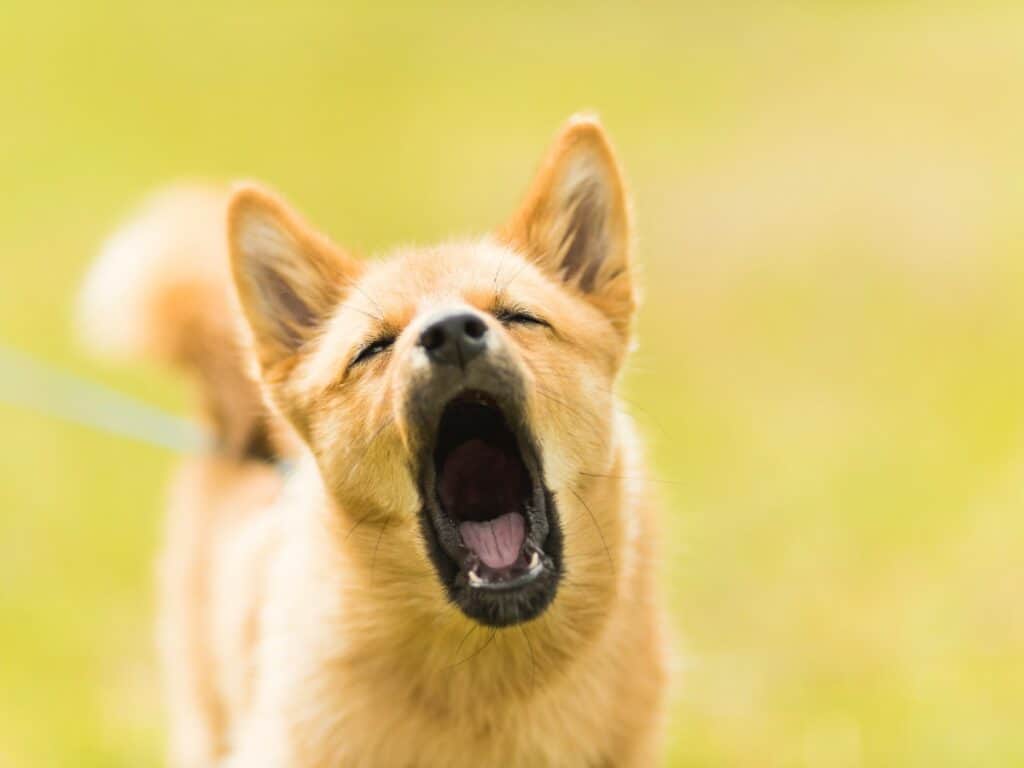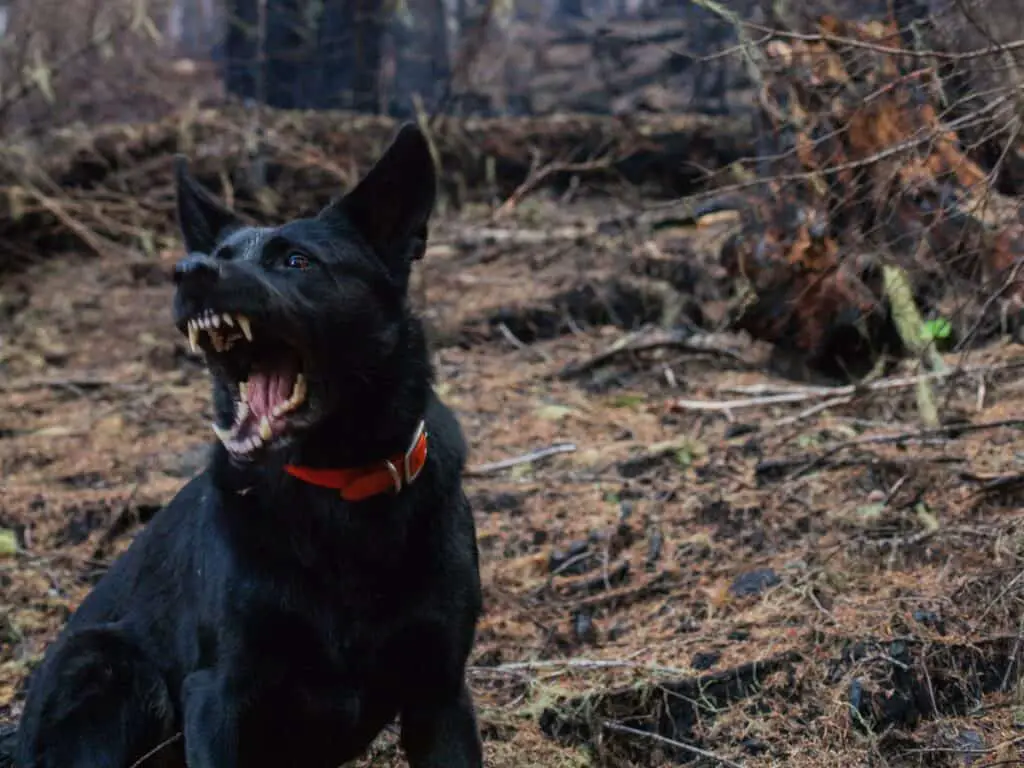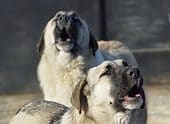When you see a dog growling at you, your instinctive response is probably to back off slowly and get out of there. And that’s because we think of a growling dog as an aggressive animal and a clear warning sign to stay away from them.
And that’d be true if we were dealing with a wild animal. But for dogs, a growl isn’t necessarily a threat. Instead, it could also mean they’re happy, excited, anxious, scared, and even in pain.
But what about when a dog stares and growls at nothing? Sure enough, this can be a confusing and strange sight. However, a dog growling at nothing can be indicative of different meanings:
- They see something you can’t.
- They smell something you can’t.
- They hear something your can’t.
- They’re scared.
- They’re ill.
In this article, we’ll answer every dedicated pet owner’s question, “Why does my dog growl at nothing” and we’ll provide tips on how you can help your dog.

Different Types of Dog Growls
A growling sound doesn’t necessarily mean that your pet is angry. Knowing when a growl means something else will help you better understand your pet. Learn the different types of growls you’ll hear.
Dog growling when playing
Out of all the kinds of growls, this is the one that you may hear excitedly. And that’s because playful growling indicates that your dog is probably having a good time playing rough — paying tug-of-war, wrestling, and doing other aggressive activities.
However, don’t be alarmed when you hear your dogs growl while playing with someone else. It usually means they’re just having fun and not trying to hurt anyone.
The main things you should watch out for during this period are their body language and how much energy they’re putting into the game. Do they seem happy and excited about what they’re doing? Or do they look tired and sluggish? If they’re getting too worked up, then you may want to take them off the field for a short rest.
Dog growling when anxious
Have you ever noticed your dog growl for no apparent reason? This may be due to anxiety. Anxiety usually happens when your dog is not used to its surroundings or if something changes unexpectedly. For example, they might start acting out if you take them to a different place where there are new things to see, hear, smell, taste, and touch.
Some dog breeds are more likely to show anxious behavior when encountering something unfamiliar, but this kind of anxiety can be reduced through early socialization and training.
When an anxious growl comes out, it usually lasts for a short period. It may even border on manic movement. You can calm down your dog by giving them gentle, soothing strokes and letting them get used to the situation.
Dog growling when frustrated
Frustration growling is very similar to anxiety growling; however, frustration growling is usually directed towards a specific individual or situation.
If you’ve been playing fetch for almost an hour, chances are your arm will become tired. And even though you’re ready for a break, your dog might not be. Instead, they may growl in frustration because you aren’t tossing the tennis balls when they want one more round.
Frustration growls aren’t aggressive, but they’re not friendly, either. Because of this, if another dog or person sees your puppy doing it, they might misinterpret its meaning. They might think it’s an aggressive move and get defensive.
Growls usually have a varied pitch and tone to them. Your dog might even begin whining while growling. Their body language may become more focused, like when they’re anxious; however, it will not be as manic as when they’re frustrated.
Dog growling when threatened and scared
Some dog breeds may quickly scam away from danger, but others will stay put and bark. And the first thing these animals usually do when they sense danger is to let out a loud growl.
When dogs feel frightened, that does not necessarily imply that they are about to attack – but this is one of these occasions where they may just do so. If a canine feels frightened and barks at you, the best action is simply to give them their space. If your pet is leashed and is growing loudly at something (or somebody) else, it’s best to take them out of the situation. It’s not always best to try and make your dog befriend people.
A fearful growl usually has a low rumble with a closed mouth. In addition, your dog will show stiff body posture, and they might hold their breath.
Dog growling when in pain
When we’re ill, our pets may get upset because we don’t want to be bothered. They also want to be left alone if they feel under the weather. So what do you do? Let your dog rest!
However, it’s not just sickness. A dog may have physically hurt itself and be in pain. A growl is one of the most common signs that your dog is in pain. Growls are normally accompanied by barking. Barking is a low-pitched noise that ranges from a tiny squeaking to full howling.
There’s a good possibility that the intensity of their growls will increase if you touch or approach them. This isn’t because they don’t like you, but because they fear more harm will happen. If you notice any signs of pain in your dog, the best thing you can do is take them to a vet right away.
Read also: 13 Reasons Why Your Dog Suddenly Screams
Why Does My Dog Growl at Nothing? Five Possible Reasons
If your dog growls at nothing, it may indicate something important. So rather than punishing your dog for growling, you must figure out the cause of the growl and fix it.

Your dog smells something.
Dogs’ sense of smell is far superior to ours. This is because they pick up so much more info from just one sniff.
A dog has an estimated 300 million olfactory receptor cells (compared to 6 million in humans), and its part of the brain that analyzes smells is approximately 40% larger than ours. Also, dogs are naturally drawn to new and interesting scents because of their adaptive trait called neophilia.
That said, their sense of smell picks up all kinds of invisible things. Let’s put it this way: Dogs can smell things at levels so low they’re almost impossible for us to perceive. So what does that mean for us? While we may be unable to detect a sugar drop in a cup of coffee, a dog can smell a sugar drop in an ocean.
Your dog hears something.
Like dogs’ noses, their senses of hearing and smell are exceptional among all animals.
It’s not hard to tell from just their ear shapes whether dogs can hear better than people. Their larger ear shapes allow them to take in more sounds than our tiny ears. They can detect soft sounds at decibels (-5dB to -15dB), whereas we just can’t.
Their ears have strong muscles that allow them to control them in a wide range of ways. For example, they can raise them up or down or even turn them sideways. And they can point them independently, so they can pinpoint exactly where a certain sound is coming from.
Furthermore, dogs can actually pick up sounds that go beyond our own human ranges. A study found that dogs can detect sounds between 45–67,000 Hz3. That means that dogs can detect sounds that are above the highest pitch that humans can perceive.
Your dog sees something.
Dogs’ eyesight is extremely different from ours. The science behind this is quite complex. In short, we can see better than dogs can during daylight hours, but not at night or in poor light conditions. They have better vision than we do.
In low-lighting situations, such as inside a building, a person’s eyesight may not be able to distinguish colors clearly enough to read comfortably. However, a dog’s vision is much sharper than a human’s. A dog’s eyes contain a special type of tissue called a tapetum lucidum, which reflects incoming rays of sunlight so they can penetrate deeper into the eye. Because of this, a dog’s eyesight is much better in dim lighting than a human’s.
Also, dogs’ retinas have more rods compared to human beings. Those are the rod photoreceptors that detect low levels of illumination. They help dogs to perceive things in dim conditions. However, because of the presence of the tapetum lucidum, dogs require only half the amount of illumination needed by people to view objects clearly. Therefore, if your dog barks at something in the darkness, he might just be seeing something that you cannot.
Your dog is scared.
Another common reason why dogs growl at nothing is that they’re afraid. Growling is their natural way of expressing anger, hostility, and aggression. If your dog encounters something frightening, it may growl in order to seem more aggressive.
For instance, some dogs are afraid of thunderstorms. They might bark and run away from them, whereas other dogs growl at seemingly nothing. Other sights that only your dog can see may scare your dog, making them look like they’re growling at nothing.
Your dog is sick or injured.
Your dog may be growling at nothing because of an injury or illness. If you’re holding your dog too tightly, he may start growling because he feels uncomfortable. Usually, injured animals exhibit this kind of behavior.
If your dog has not been hurt, look for these other signs: loss of appetite, reduced interactions, vomiting, lethargy, defecating with blood, decreased water intake, and restlessness.
On the contrary, some dogs with dementia may suddenly start growling when no one is around. They might be anticipating something bad happening and want to warn others so they don’t get hurt.
What Should I Do If My Dog Growls at Nothing?
Acknowledge the problem.
One way to deal with this kind of barking is to recognize it. After all, if your pet is barking because they perceive something dangerous, then acknowledging this concern can help them relax. A “You’re fine” or “It’s okay” lets your pet realize that you’ve noticed his alarm and that everything is fine. Some dogs may require only one calming word before they’re ready to return to sleep.
Transfer your dog to another room.
If your dog starts barking from another part of the house, it might be because they’re scared. They might be feeling lonely or anxious about being left alone. Separating dogs can cause them stress, so if you’re worried about your dog, try to keep them close.
Exercise your dog’s mind.
If your dog gets frustrated, it might start growling suddenly. You can prevent this by doing things like taking them for walks outside and playing games with them.
By using this method, your dog won’t be confused by unfamiliar noises and objects anymore.
When going for walks with your pet, use positive reinforcement instead of negative reinforcement. Dogs who get negative reinforcement only become more stressed.
Turn to a vet.
Growling may be caused by a medical condition. We’ve mentioned that growling could be because your dog is injured or ill.
If you notice any sudden growling or other symptoms, take them to the vet immediately. It’s also important to note that older dogs are more likely to develop health issues than younger ones.
Seek a dog behaviourist’s help.
If you don’t understand why your pet growls at nothing, look for a professional specializing in animal behavior. Also, ask for recommendations from people you know.
Related Questions
Do dogs growl when they’re happy?
Some dogs growl affectionately if they’re being petted or as an expression of their desire for affection. Some people may interpret this behavior as a threat, but it really means that they’re happy.
Why is my dog growling at the wall?
If your dog hears something behind the wall but doesn’t know where it came from, it might start barking at that wall.
References
Talegón, M. I., & Delgado, B. A. (2011). Anxiety disorders in dogs. Anxiety disorders, 261-280.
Landsberg, G. M., Madari, A., & Žilka, N. (2017). Canine and Feline Dementia. Landsberg, G., Mad’ari, A., Žilka, N., Eds.
Fry, M. (2015). Cognitive dysfunction in older dogs and cats: the role of the veterinary nurse in screening. The Veterinary Nurse, 6(5), 266-274.
Zilocchi, M., Tagliavini, Z., Cianni, E., & Gazzano, A. (2016). Effects of physical activity on dog behavior. Dog behavior, 2(2), 9-14.




